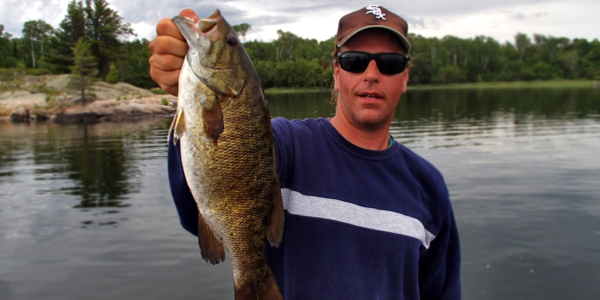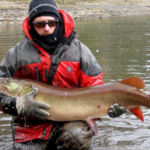By Andrew Ragas
Over the last few years, I’ve been fortunate to travel to a few Northwestern Ontario drive-to fishing destinations for a variety of adventures. Northwest Ontario has some of the best multi-species fishing opportunities in the world. Each season, I make it a priority to visit a few locations. At the top of my list is Rainy Lake.
The Minnesota-Ontario border at International Falls and Fort Frances is traversed by more than a million vehicles annually. Many of them are hunters and fishermen continuing their travels further into the heart of Canada, not realizing they are bypassing some of Northwestern Ontario’s best fishing. If seeking a world class fishing experience, anglers visiting from the US don’t have to travel any further beyond this border water. Rainy Lake is one of Sunset Country’s best kept secrets.
Within minutes of entering Ontario, a lifetime of fishing awaits. Surrounded by a landscape of pine forests and picturesque rock outcroppings, this 275,000 acre Canadian Shield lake at the Minnesota and Ontario border is one of the finest drive-to fishing waters in North America. Located a convenient six hour drive from my home base of Minocqua, Wisconsin, Rainy Lake fishing and lodging with Camp Narrows Resort has become one of my favorite places to catch smallmouth bass and walleyes.
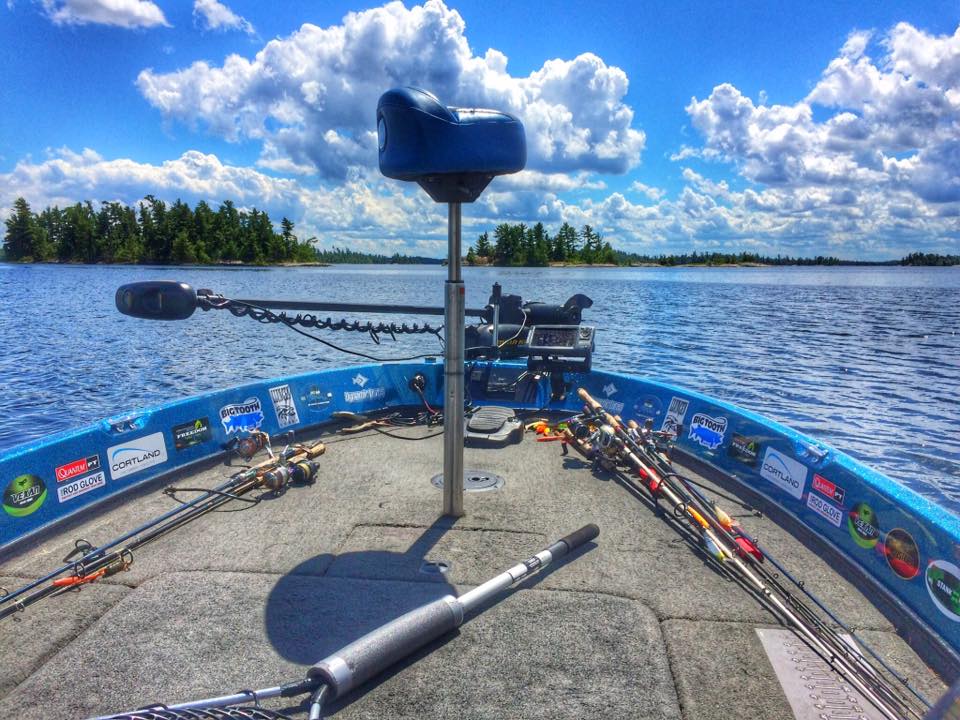
Rainy Lake is a well known fishing destination. It receives substantially less angling pressure than most other nearby and more popular Northwest Ontario fisheries. Its best fishing takes place on the Canadian side, where most of the lake’s acreage lies and fishing regulations effectively enforce conservation and catch and release.
The fertile north arm of Rainy Lake is an undiscovered fishing treasure for multi species angling. Trophy smallmouth bass, walleye, northern pike, and plentiful perch and crappies encompass the majority of this Rainy Lake fishery. Meanwhile, anglers fishing other parts of the lake such as the east end towards Voyageurs National Park (US side) and Kettle Falls can run into some other species that includes eelpout, whitefish, lake trout and some muskies too – most notably in the lake’s northeastern arm of Red Gut Bay.
Rainy Lake fishes quite easily for a reservoir environment, though she has a complex behavior. In the north arm, water levels fluctuate seasonally due to the inflows of Manitou River at the north, and Big Canoe River and the system of lakes formed by the Pigeon River system at the east. Most fish species locations and activity is thereby driven by current. Some wind helps trigger fish to feed too, though. Additionally, good habitat leads to good fishing. With its gorgeous rock walls and island formations, mazes of underwater reefs, and endless protected bays and coves growing lush and virgin cabbage beds, anglers have no shortage of good fishing locations for all species.
Smallmouth Bass
Can you say bronzeback heaven? That’s the most accurate assessment of the Rainy Lake smallmouth bass fishery. Northwest Ontario is the northernmost point of the smallmouth bass range in North America. The biggest draw for Rainy Lake and many of its lodges and resorts is bass fishing. Several high profile tournaments that include the Fort Frances Canadian Bass Championship and International Falls Bass Championship have brought a lot of national attention to its great bass fishery.
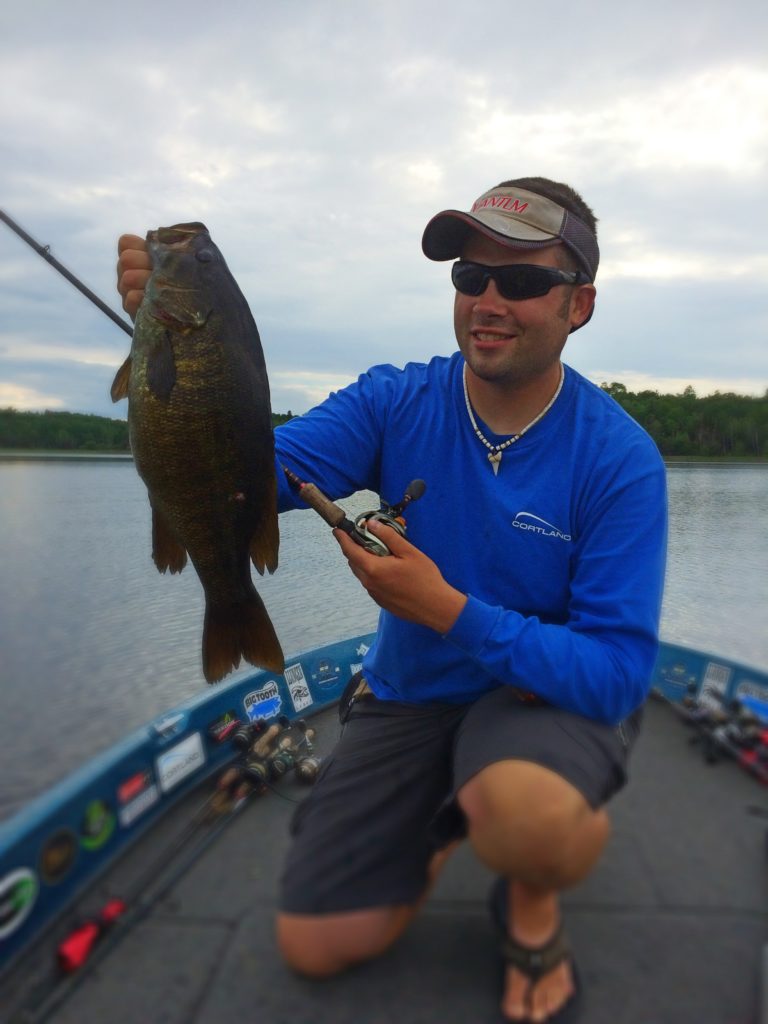 Although the Rainy Lake bass fishery was at its pinnacle 10-15 years ago when smallmouths dominated the biomass, it remains a top fishery in all open water months. The resurgence of walleyes in recent years has balanced out the population and moderated smallmouth numbers, but an awesome fishery still exists. Bass fishing at Rainy Lake’s north arm is world class, and can be quickly experienced within five minutes from the docks at Camp Narrows Lodge.
Although the Rainy Lake bass fishery was at its pinnacle 10-15 years ago when smallmouths dominated the biomass, it remains a top fishery in all open water months. The resurgence of walleyes in recent years has balanced out the population and moderated smallmouth numbers, but an awesome fishery still exists. Bass fishing at Rainy Lake’s north arm is world class, and can be quickly experienced within five minutes from the docks at Camp Narrows Lodge.
The smallmouth fishery is dominated by action size 14 to 18 inchers, with most averaging 2.5 to 4 pounds. Several year classes of smallmouths are present. They’re aggressive, jump high into the air, and are a lot of fun. With good numbers of fish, there are some large ones present too, and the lake sometimes produces fish surpassing 5 and 6 pounds.
The most popular time of season to fish Rainy Lake smallmouths is right after ice out, which typically occurs in early May. At this time, smallmouths are pre-spawn and with calm warming weather fish by the hundreds move onto shallow rocky structures to feed. They can be caught on these shallow flats by throwing hair jigs, suspending jerkbaits, and shallow running crankbaits. Fly fishermen can experience an onslaught of smallmouths in the shallows as well.
From late May through June smallmouths gather again in post-spawn mode, piling up on the first main lake points leading out of big spawning bays, where they will roam the open water for smelt and pelagic bait species soon after.
Suspending jerkbaits such as a Rapala Shadow Rap 11 and X-Rap 08 and 10 are always preferred choices, but a soft 5 inch fluke style jerkbait Texas rigged weightless or rip jigged is quite possibly the lake’s best fish catcher of all time. Depending on whether fish have been conditioned or are picky, it pays to experiment with different styles of plastics as most have different sink rates and scent impregnations. My most successful this season was a 5 inch handpoured minnow from Bearpaws Handpoured Baits, and 5.25″ Stankx Bait Co. Jerx, rigged with a Trokar Magworm with bait collar that provided a seductive slow sink rate. In addition, tubes rigged weedless, small paddle tail swimbaits rip jigged, and 5-inch Kalins swimming grubs in crayfish and smelt color patterns are fish-catching staples too. Due to the prevalence of boat-crushing lure-donating snags, bottom-hugging baits are usually out of the question unless you know where the sand bars and beach shorelines are located.
By mid summer, fish move onto adjacent rocky habitat where they will consistently hold during the rest of the season. There are many rocky points and reefs adjacent to deep water that hold fish. Developing by mid to late summer, the lake’s abundant cabbage weedbeds and bulrushes also provides habitat the fish like. Shallow weedbeds attract schools of fish, and if you can find some rock mixed in, you have a high profile spot that’s capable of holding fish often.
Often, a little wind and wave action gets smallmouths more active, and tremendously helps the fishing. I’ve learned that the hard way. Calm windless mid summer days on Rainy really suck.
In summer, my boat frequently has to hunt for the working pattern because conditions tend to change daily. We often cover water with search lures such as the trustworthy chartreuse spinnerbait, or white #5 Mepps inline spinner. When one fish is caught, others will be nearby. Once fish are found with some consistency and we have their locations dialed in, we will focus on them slower and more effectively with topwaters and soft plastics.
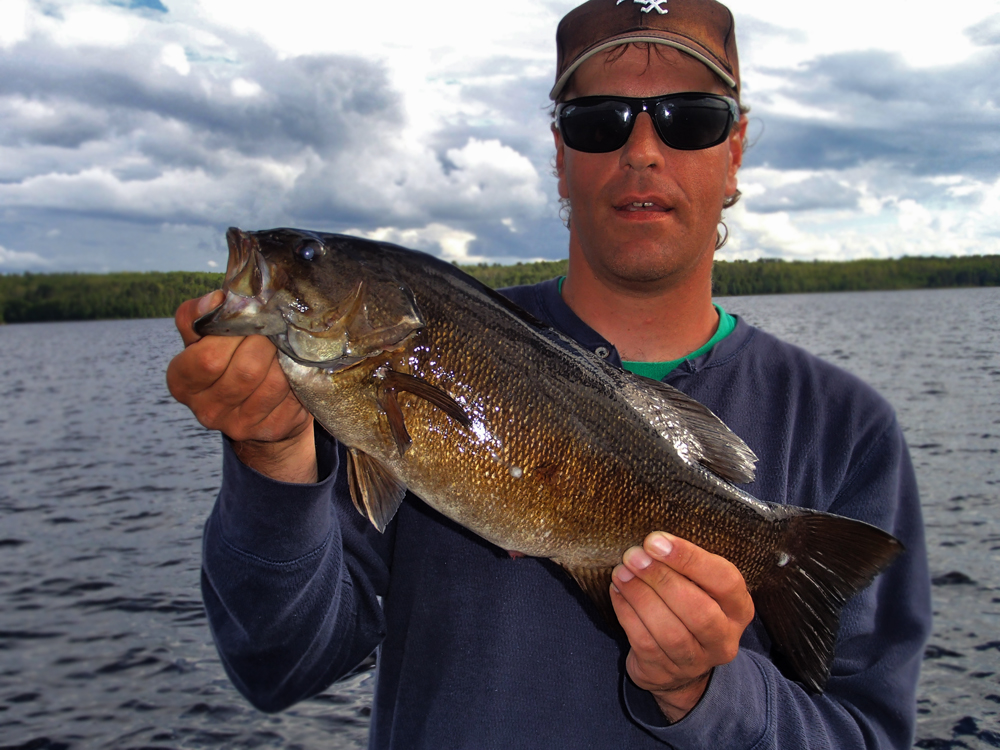
Before setting out for the day, plan a milk-run strategy for covering acres of water and as many as 30 to 40 spots per day. Wisely select a section of the lake to fish, and go learn it. Take a long boat ride and motor to the farthest point to begin your day of fishing, and slowly fish your way back to camp. Revisit all of your waypoints and build upon these new spots and your locations the next day.
Anglers who like to fish with topwater baits can experience exciting fishing throughout the mid-summer months. While hot weather causes bass to slide into deeper water down to the thermoclines, the opposite actually happens on Rainy Lake. A movement of smallmouths pushes them into shallow main lake rock and cabbage beds. A topwater like a Rapala X-Rap Pop and Zara Spook being worked into their strike zones will often catch them.
Covering water with topwater poppers, walk-the-dog baits, and prop lures works well. And once you find fish, it’s not uncommon to uncover wolfpacks of smallmouths prowling in weeds where you can sight fish them with black hair jigs, wacky rigged senkos and stickbaits, and weightless soft jerkbaits.
I’ve been told fall fishing, which I have yet to experience, might be the best time of the year for Rainy Lake smallmouths. The fall period, lasting from mid September till first ice is, nothing but a feeding binge of schooling fish, and a spectacle of trophy fish to experience.
Walleye
Walleyes are more plentiful now than ever and also grow big, all thanks to the ban on commercial fishing and the revised emergency regulations enacted during the 1990’s. It wasn’t more than 15 years ago when the Rainy Lake walleye population crashed from over harvest and the abundant and invasive rainbow smelt populations. Today, the average size walleye of Rainy Lake runs between 20 to 25 inches. There’s also a lot of fish in the system surpassing 10 pounds too, caught frequently during the spring spawning runs, the late fall binge, and through the ice.
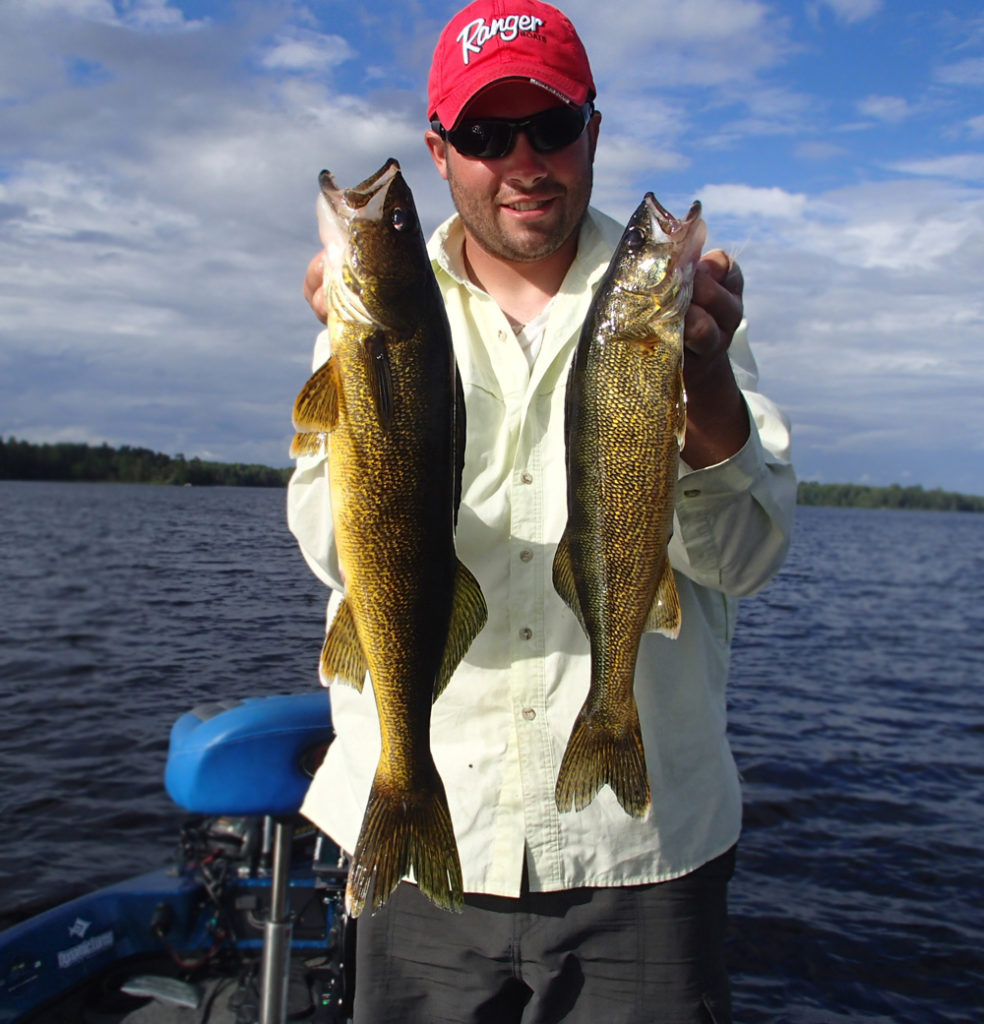 Rainy Lake’s abundant walleye fishery is one of the best in all of Canada for both numbers and trophies. Within minutes away from Camp Narrows, walleye anglers can catch fish off the many plentiful rock humps by vertical jigging and livebait rigging methods. When presented with the right conditions, single line trolling with deep diving crankbaits and spinner rigs along rock walls, mud flats and weedlines will produce larger fish. Additionally, casting windblown rock points with crankbaits and minnow plugs will catch plenty of action, too.
Rainy Lake’s abundant walleye fishery is one of the best in all of Canada for both numbers and trophies. Within minutes away from Camp Narrows, walleye anglers can catch fish off the many plentiful rock humps by vertical jigging and livebait rigging methods. When presented with the right conditions, single line trolling with deep diving crankbaits and spinner rigs along rock walls, mud flats and weedlines will produce larger fish. Additionally, casting windblown rock points with crankbaits and minnow plugs will catch plenty of action, too.
Due to the lake’s walleye resurgence in the last decade, resulting from the crash of its smelt population and implementation of a 13 ¾ – 17 ¾ inch slot in which everything between 18 to 26 must be released, many anglers believe the walleye’s abundance on rock and deep open water structure has forced populations of the lake’s smallmouths into these areas making them a more weed and vegetation-oriented fish. This unique displacement is common on many northern bass fisheries where walleyes dominate the biomass like Rainy.
During summer and fall, many walleyes hold on deep-lying rocky humps and points. At times, fish also roam open water near these structures. Fish push shallow frequently, making them vulnerable and easy to catch casting with crankbaits and paddletail swimbaits.
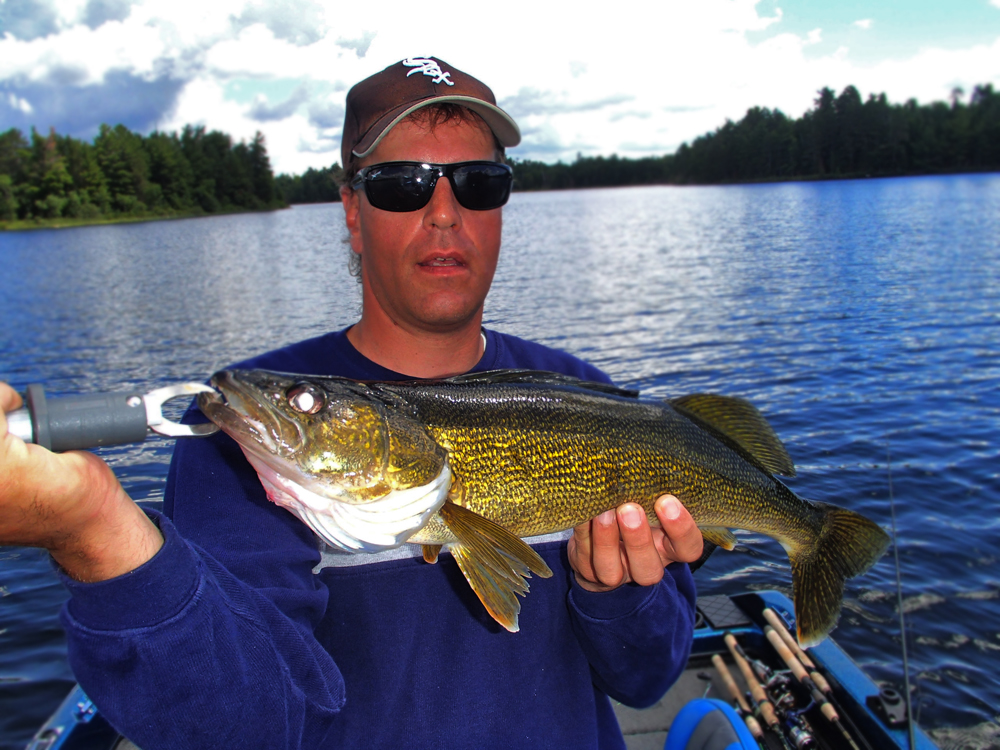
If you and your partner fish with a conservation license, where else can your quick limit of two walleyes be caught on 2 casts within 30 seconds? Look no further than Rainy Lake. I think it happens a lot throughout Canada, but LOADED with walleyes is an understatement.
Northern Pike
Pike also are abundant and grow big, with some fish surpassing 20 to 30 pounds. Early spring following ice-out and fall provide best trophy opportunities where the largest specimens of Rainy can rival the biggest pike anywhere in Canada. Cabbage beds are an important factor during summer and fall, but they often use the same main lake rocky structures frequented by the bass and walleyes if forage is present. Rainy Lake pike respond favorably to wind, current from all the river inflows, and funnel areas in between islands and rock points where baitfish get trapped due to windblown currents.
Rainy Lake is one of North America’s best destinations for big trophy pike due to its diverse habitat, abundant forage, and faster growth rates. Although the fishery is world class for drive-to destination standards, it seems that you have to catch an average of 50 undersize 20 to 30 inch fish before eventually catching one surpassing 40 inches or larger. Casting weedbeds and single line trolling spreads run along the edges of windblown rock points and walls are favored. Trolling especially excels in mid summer and autumn.
Want to catch pike efficiently? Rig up one of your downsized musky sticks or a heavy fast action bass flipping stick spooled with 50 lb. braid. Make sure the rod can handle lure weights varied from as small as ½ oz. to as large as 3 oz. for a combination of casting and trolling. Be sure to include a small arsenal of tackle and that’s all you’ll need to catch pike. The first option should be casting minnow-imitating plastics such as oversize flukes, and swimbaits. A 5 to 7 inch minnow profile is all that’s required, and can be fished successfully through cabbage beds and the rock reefs big pike prefer.
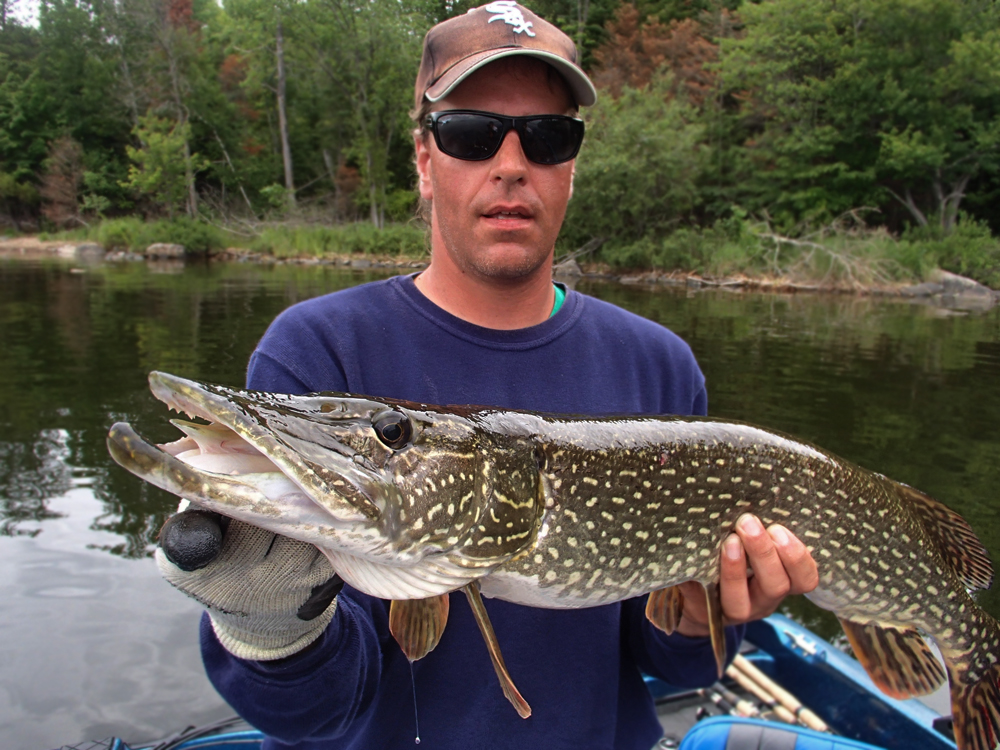
On calm days throughout spring and summer, walk-the-dog topwaters, something in the 5 to 8 inch size range, are a personal favorite and lead to entertaining and highly motivating days on the water in mid summer. They tend to weed out small annoying fish in favor of larger specimens. Meanwhile, casting jerkbaits and burning bucktails and spinnerbaits score lots of fish too when they’re active and want to chase fast baits.
Many anglers fishing the north arm of Rainy Lake catch pike annually up to 45 inches, with even the occasional sighting of some special 50 inchers. The Ontario side of Rainy Lake is loaded with underfished pike of all sizes.
Despite the abundance of juvenile pike seemingly on every rock point, grass bed, and weedbed, Rainy Lake’s northern pike fishing is indeed some of the best in Northwest Ontario due to its slot size and mandatory catch and release of fish greater than 27.5 inches. Casting deep weedlines with topwaters, bucktails and crankbaits, single line trolling along rock walls, points and reefs with crankbaits and large minnow plugs, and fly fishing are effective ways to catch them.
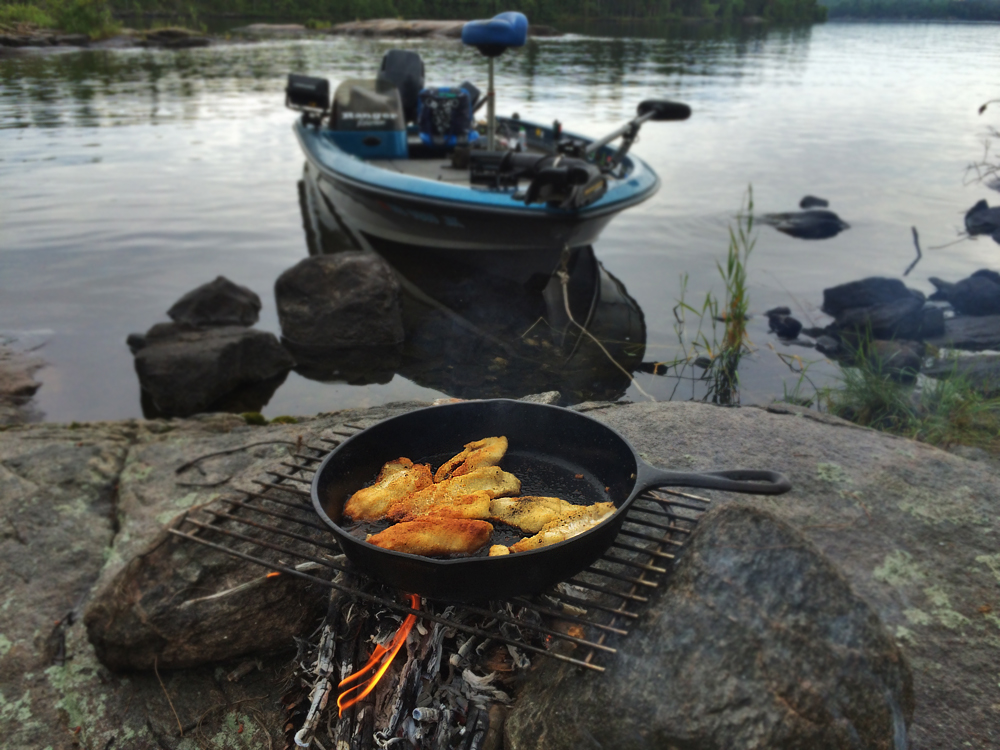
Rainy Lake’s outstanding multi-species fishing isn’t limited to just the open-water season. Hard core ice anglers will find lodging and resorts on the north arm and along the US side catering to winter fishing. While I’m not well versed in ice fishing, the benefits of ice fishing Rainy Lake includes the potential to catch walleyes surpassing 10 pounds, pike exceeding 20 pounds, and crappies and perch that make for awesome meals.
Because Rainy Lake is a paradise for multi-species angling and all of its major fish species can be had in every section and basin of the lake, the question of what to fish for doesn’t apply here. Walleyes, northern pike, smallmouth bass, and crappie can be caught from anywhere at any time, and often times by accident when targeting a single species.
Due to Camp Narrows centralized location in fertile productive water, most of my favorite fishing areas are located within 5 to 10 miles away from camp. Because of Northwest Bay’s abundant walleye population and trophy smallmouth bass component, Camp Narrows visitors tend to fish the nearby bays and basins of Northwest Bay, Lyons Bay, Halfway Inlet, Shelter Islands, Browns Inlet, and Turkey Island basin. Meanwhile, the explorers and aggressive anglers like me may elect to take longer runs with the Ranger and travel farther north or east into the lake’s more remote locations such as Alexandria and Ash Bays, Manitou Sound, Canoe River inlet, and clustered regions of main lake islands.
Owned and operated by Tom Pearson, Camp Narrows Lodge offers anglers the opportunity to experience a unique wilderness fishing adventure at a boat-in resort. As a drive-to destination, fishing at Camp Narrows Lodge for the week is an affordable trip in comparison to most premier Canadian fishing getaways and outpost camps. Popular with the majority of his guests, Pearson offers cabin rentals with basic housekeeping plans. However, bring your own boat and meals for the week like most serious fishermen do and it’s even more budget friendly.
All facilities at Camp Narrows are fully modernized and offer a panoramic view of Northwest Bay. Anglers will find the ultimate in relaxation in its clean cabins and comfortable furnishings. With eight cabins on site, Pearson is able to accommodate small groups of two all the way up to a party of forty.
The remote location of Camp Narrows lodge provides serious anglers and outdoorsmen with a convenient location, and a world of endless water with many sought-after gamefish species. To get there travel from Duluth, MN, along highway 53 through North Central Minnesota to International Falls. Cross the Rainy River into the Fort Frances Port of Entry. When granted access into Sunset Country, take Highway 11 to Devlin (approx. 14 miles) and then turn north on highway 613. Drive for 14 miles to the public landing located at La Belle’s Birch Point Camp. Launch the boat into west bay, park your vehicle on the mainland for the week at no charge as a guest of Camp Narrows Lodge, and transport yourselves across seven miles of water to the lodge for your entire week’s trip.
Miles of largely uninhabited forests and gorgeous scenery create the heavenly landscape of Rainy Lake. Smallmouth bass, walleyes, pike and crappies headline the fishery, while more species (but of less abundance) round it out. Best of all you can drive there, bring your boat, and don’t have to travel to the end of Canadian civilization to catch fish. If you live in Minnesota or Wisconsin, long weekend fishing getaways await you! Close proximity to the US border for quick travel and customs, but remote with really light fishing pressure too. Please excuse me while I start packing for the next great Rainy Lake adventure in 2017.
LODGING / CONTACTS – Camp Narrows Lodge: Contact Tom Pearson at fishing@campnarrows.com, or call toll free 1-866-294-5067. Visit online at www.campnarrows.com and www.ontariohunting.ca Jackfish Hammy’s Guide Service: Scott Jason Hamilton, email jackfish2@bell.net, call (807) 276-1236, visit online at www.jackfish-hammys.com


